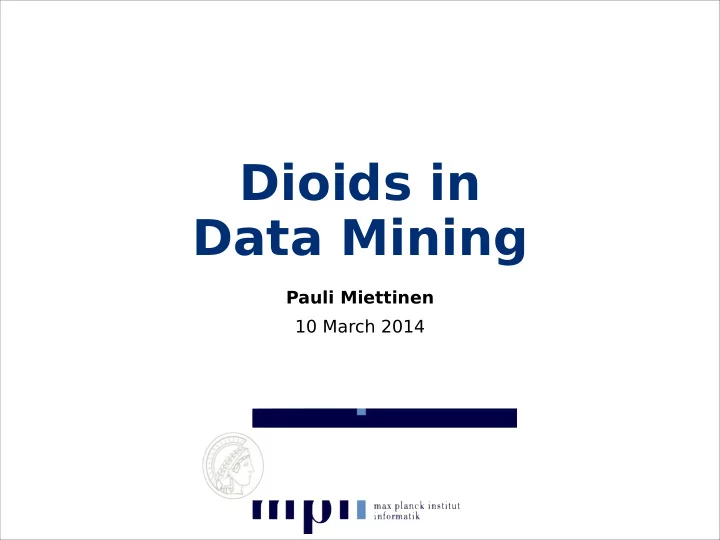

Dioids in Data Mining Pauli Miettinen 10 March 2014
What is a dioid? • Dioid is not a diode • Dioid is an idempotent semiring S = ( A, ⊕ , ⊗ , ⓪ , ① ) • Addition ⊕ is idempotent • a + a = a for all a ∈ A • Addition is not invertible
Why dioids in DM? • What happens if we replace normal algebra with some dioid? • Non-linear structure • Computationally harder problems • Matrix-factorization type problems
Why matrix factorizations? Siegfried said they’re a hot topic • Because I can • MFs model the whole data using sums of rank-1 components • Dioids change how these components interact ≈ ⊕ ⊕
Some examples (1) • The Boolean algebra B = ({0,1}, ∨ , ∧ , 0, 1) • The subset lattice L = (2 U , ∪ , ∩ , ∅ , U ) is isomorphic to B n • The Boolean matrix factorization expresses matrix A as A ≈ B ⊗ B C where all matrices are Boolean
BMF example 0 1 0 1 1 1 0 1 0 Å 1 ã 1 0 A ⊗ B 1 1 1 1 1 A = @ @ 0 1 1 0 1 1 0 1
Some examples (2) • Fuzzy logic F = ([0, 1], max, min, 0, 1) • Generalizes (relaxes) Boolean algebra • Exact k -decomposition under fuzzy logic implies exact k -decomposition under Boolean algebra
Fuzzy example 0 1 0 1 1 1 0 0 1 0 Å 1 ã 1 1 1 1 1 1 1 0 1 B C B C A ≈ A ⊗ F 0 1 0 1 0 1 0 1 2 / 3 1 @ @ 0 1 1 1 0 1 0 1 1 1 0 0 1 1 2 / 3 1 B C = 0 1 2 / 3 1 @ A 0 1 2 / 3 1
Some examples (3) • The max-times algebra M = ( ℝ ≥ 0 , max, × , 0, 1) • Isomorphic to the tropical algebra T = ( ℝ∪ {– ∞ }, max, +, – ∞ , 0) • T = log( M ) and M = exp( T )
Why max-times? • One interpretation: Only strongest reason matters • Normal algebra: rating is a linear combination of movie’s features • Max-times: rating is determined by the most-liked feature
Max-times example 0 1 0 1 1 1 0 0 1 0 Å 1 ã 1 1 1 1 1 1 1 0 1 B C B C A ≈ A ⊗ M 0 1 0 1 0 2 / 3 0 1 2 / 3 1 @ @ 0 1 1 1 0 1 0 1 1 1 0 0 1 1 2 / 3 1 B C = 0 2 / 3 4 / 9 2 / 3 @ A 0 1 2 / 3 1
On max-times algebra • Max-times algebra relaxes Boolean algebra (but not fuzzy logic) • Rank-1 components are “normal” • Easy to interpret? • Not much studied
On tropical algebras • A.k.a. max-plus, extremal, maximal algebra • Much more studied than max-times • Can be used to solve max-times problems, but needs care with the errors • If in max-plus then k X � e X k α in max-times, where k X 0 � › X 0 k M 2 α M = exp ( m � x � ,j { X � j , e X � j } )
More max-plus • Max-plus linear functions: f ( x ) = f T ⊗ x = max{ f i + x i } • f ( α ⊗ x ⊕ β ⊗ y ) = α ⊗ f ( x ) ⊕ β ⊗ f ( y ) • Max-plus eigenvectors and values: X ⊗ v = λ ⊗ v (max j { x ij + v j } = λ + v i for all i ) • Max-plus linear systems: A ⊗ x = b • Solving in pseudo-P for integer A and b
Computational complexity • If exact k- factorization over semiring K implies exact k -factorization over B , then finding the K -rank of a matrix is NP-hard (even to approximate) • Includes fuzzy, max-times, and tropical • N.B. feasibility results in T often require finite matrices
Anti-negativity and sparsity • A semiring is anti-negative if no non-zero element has additive inverse • Some dioids are anti-negative, others not • Anti-negative semirings yield sparse factorizations of sparse data
Conclusions • Idempotent semirings capture non-linear structure • Some are already used in DM • More abstract view should help finding connections • Max-plus algebras can provide tools for other problems
Abstract DL 12 April Paper DL 16 April
Recommend
More recommend